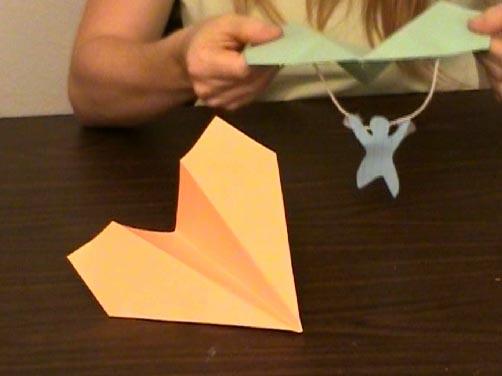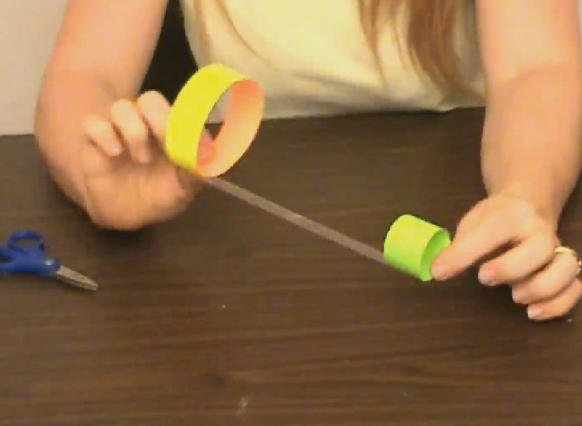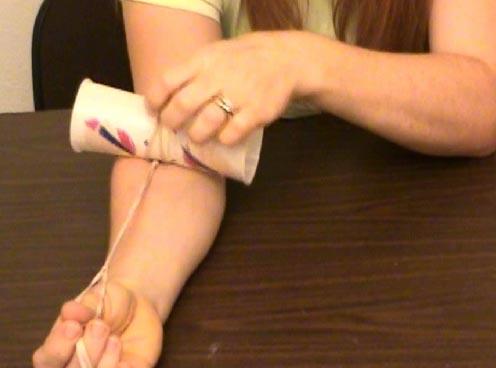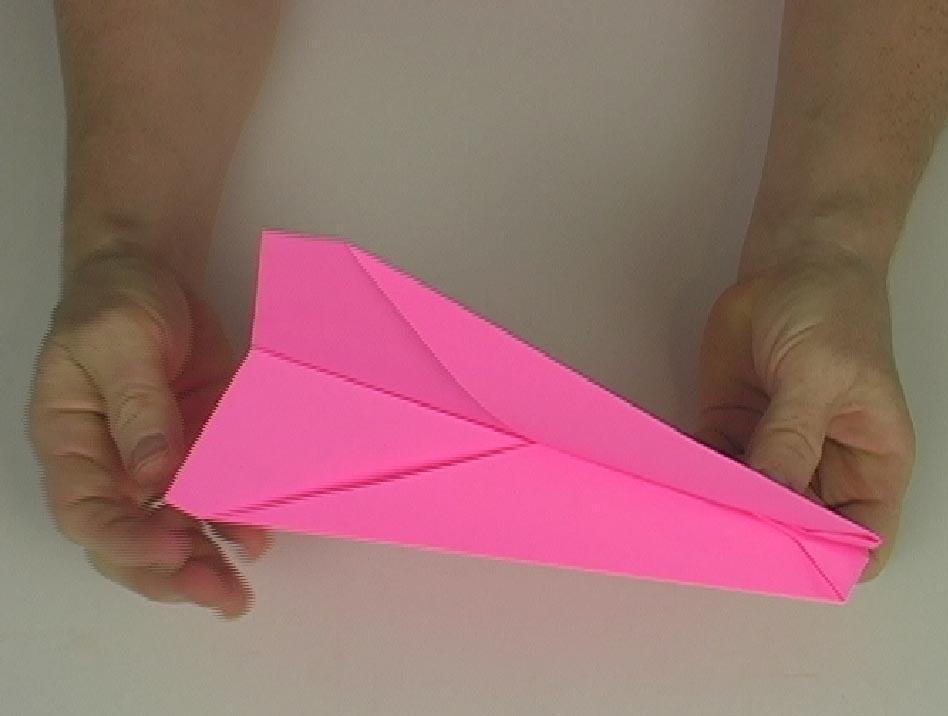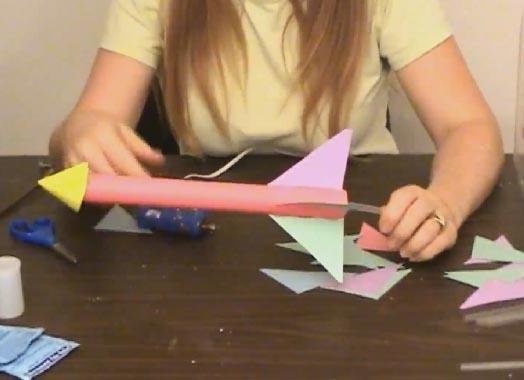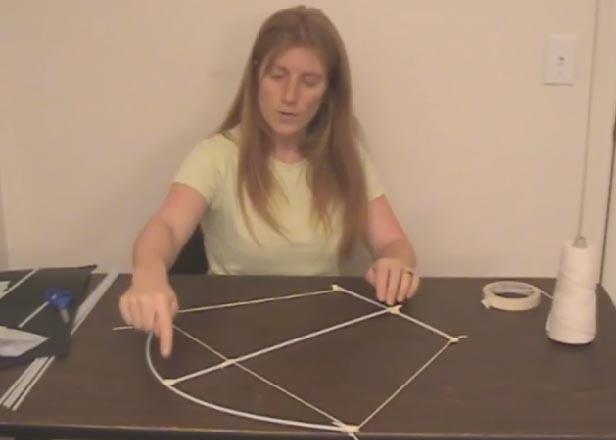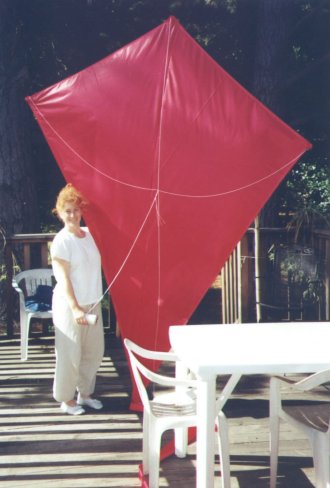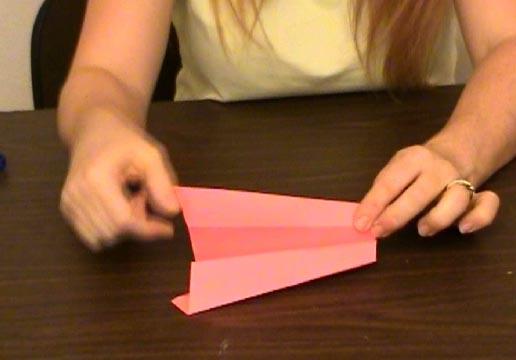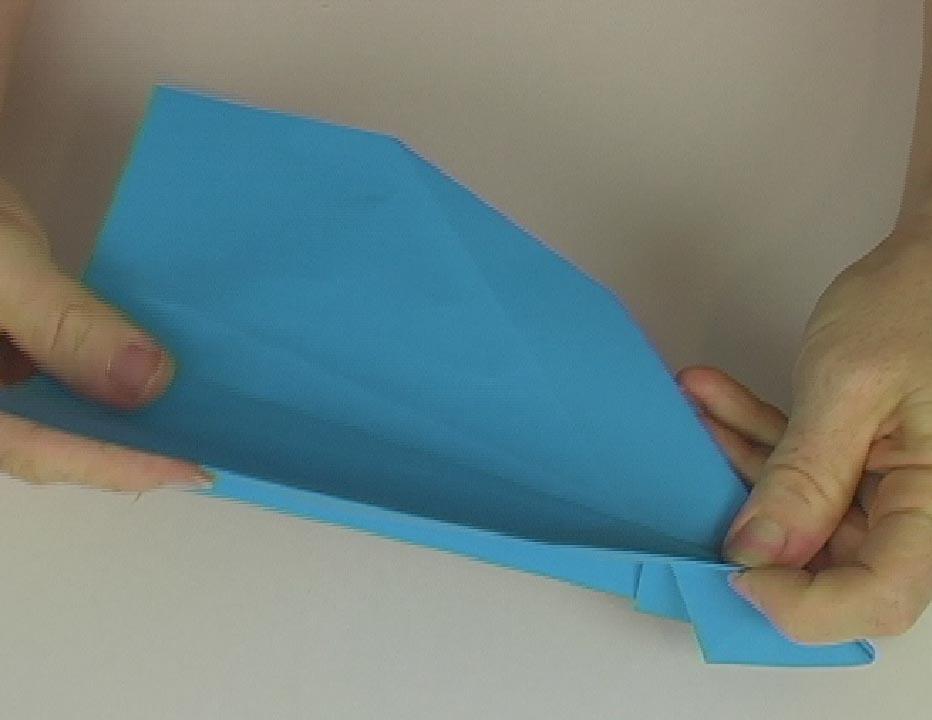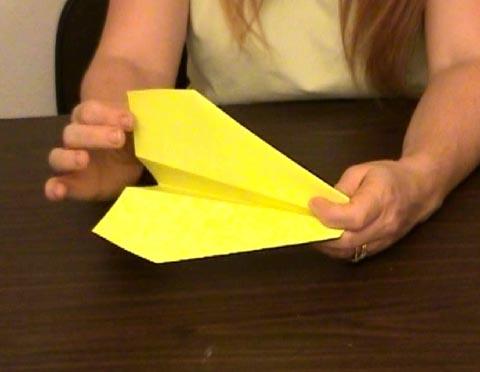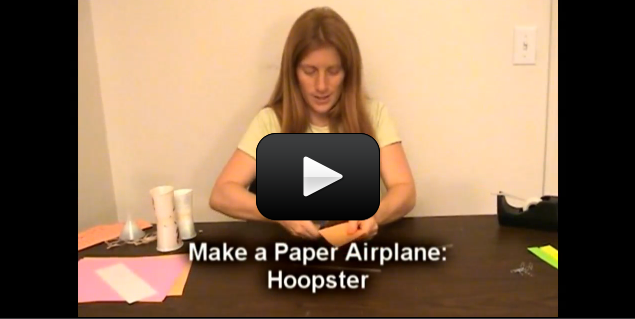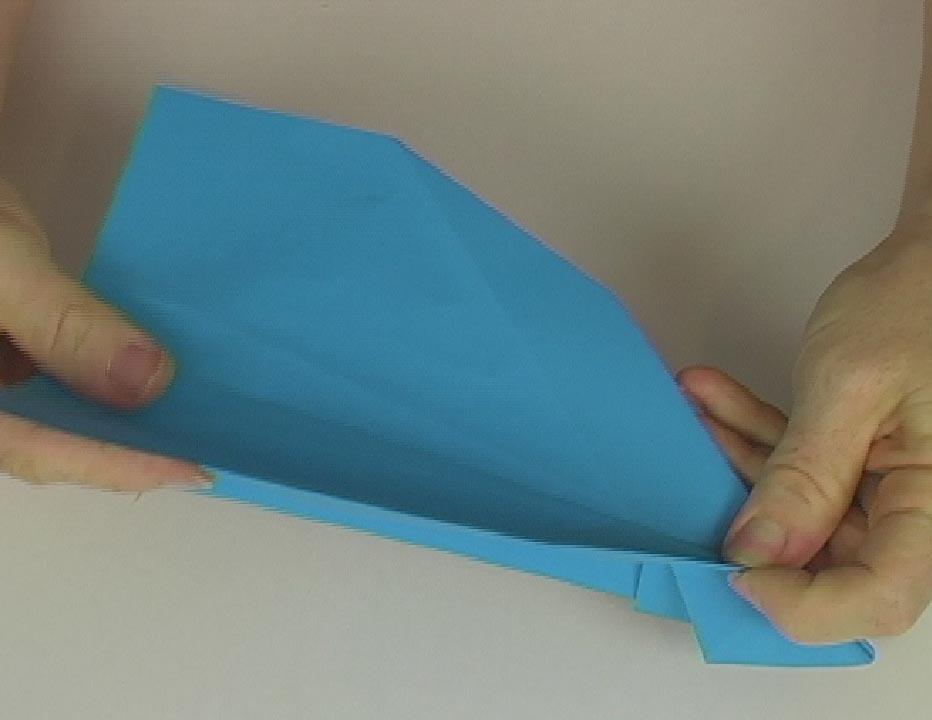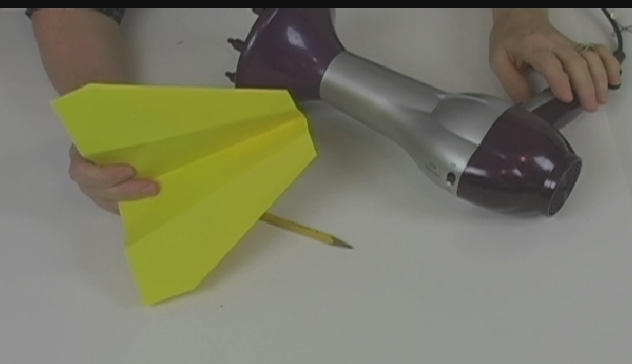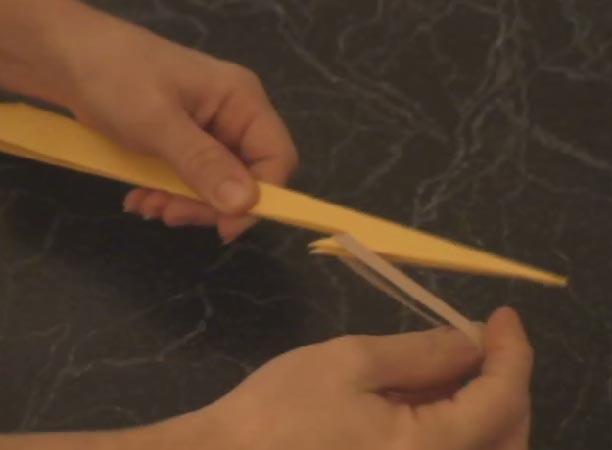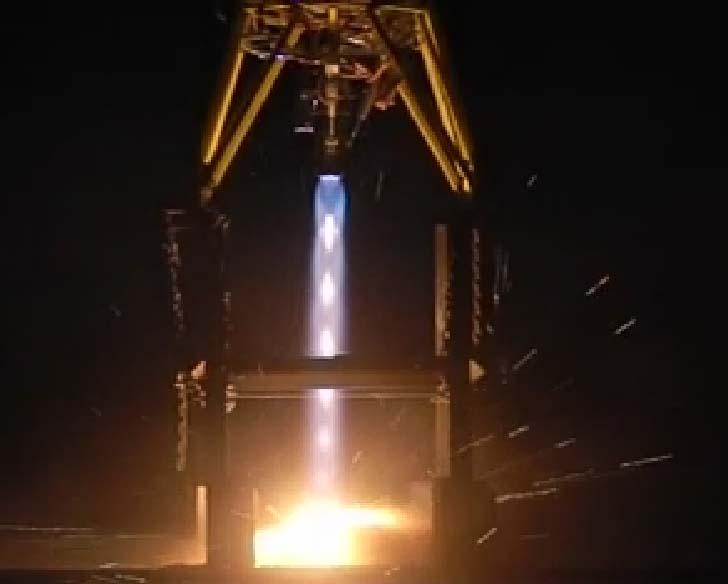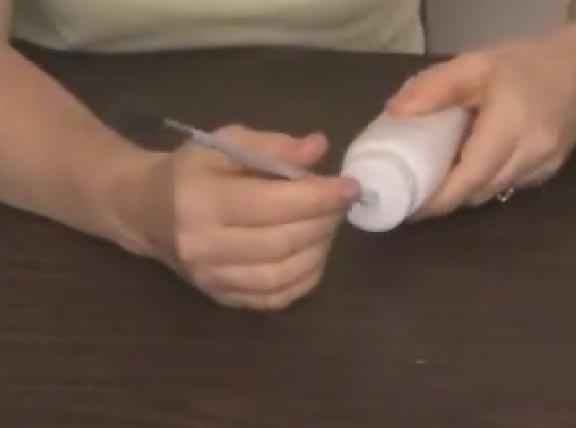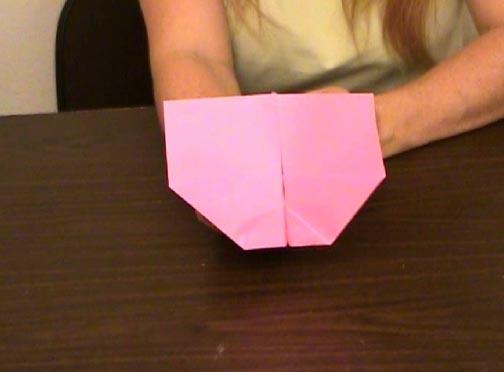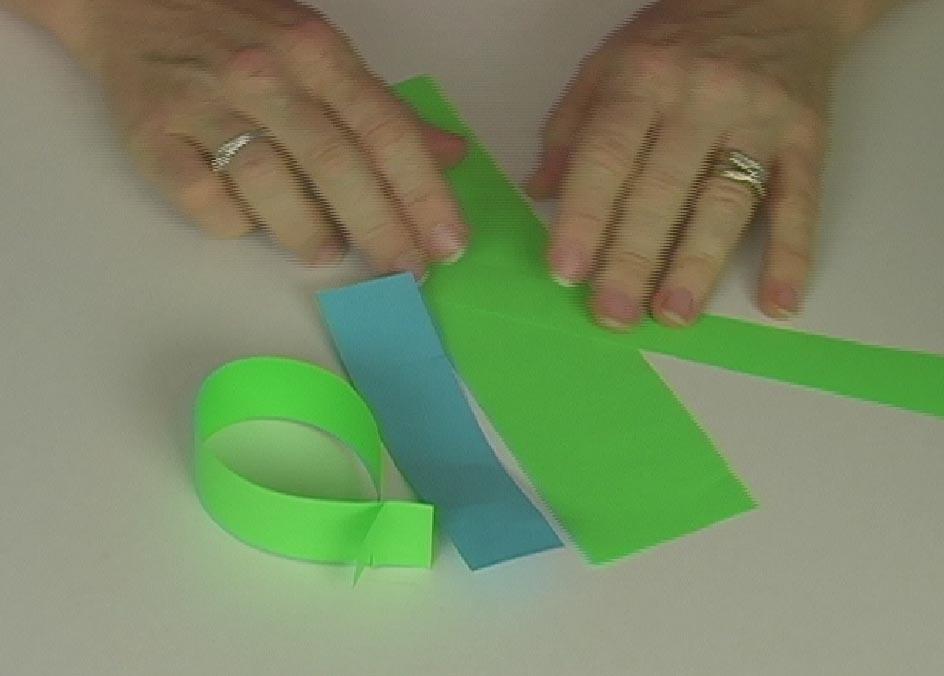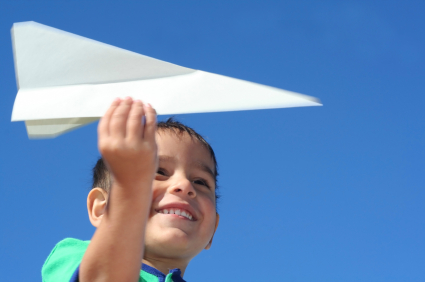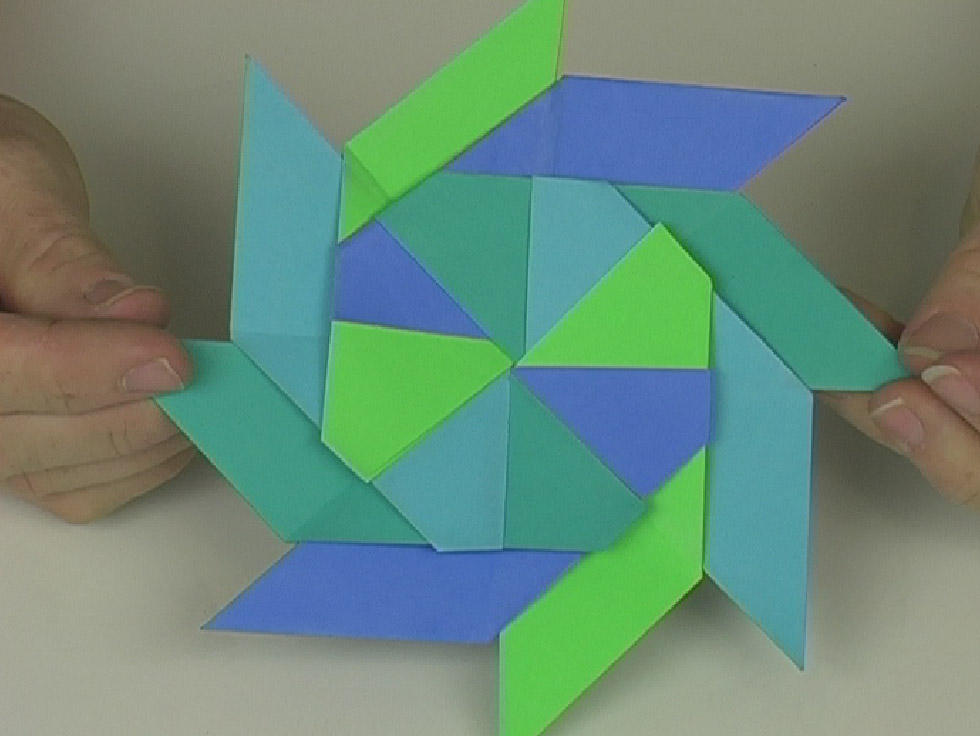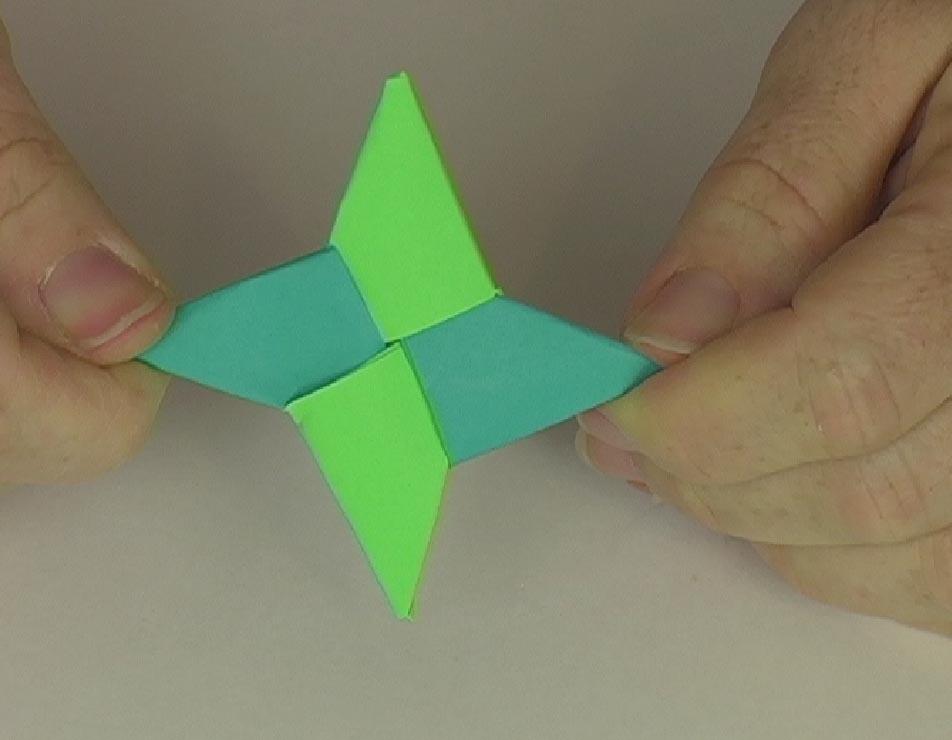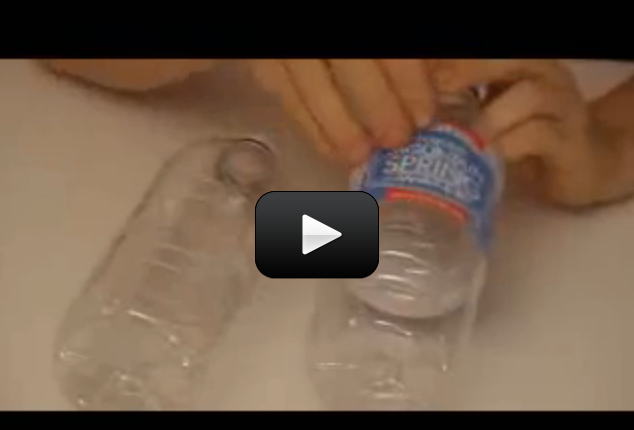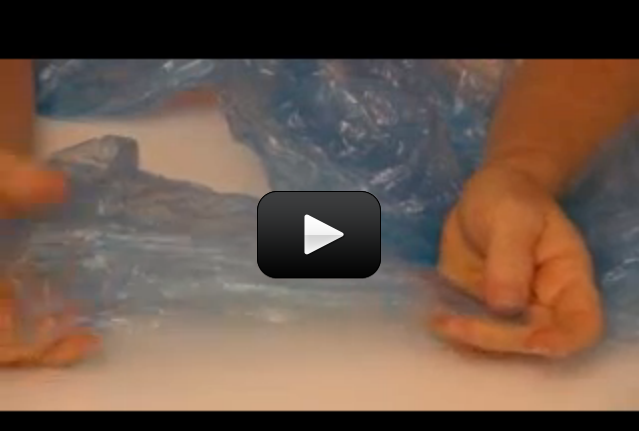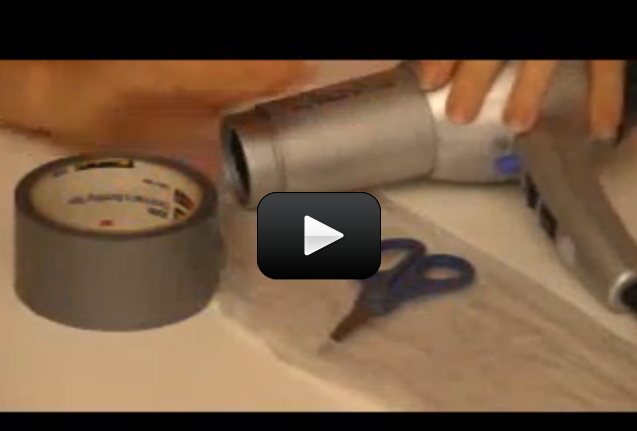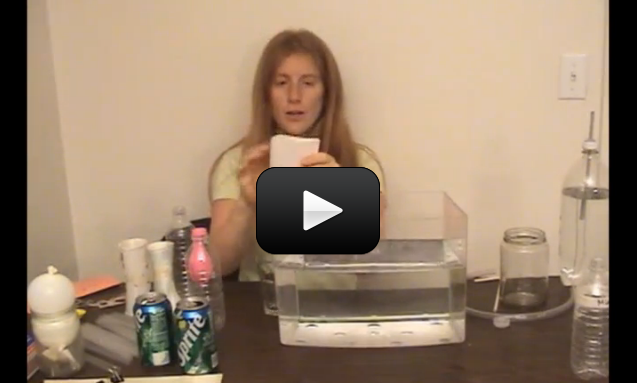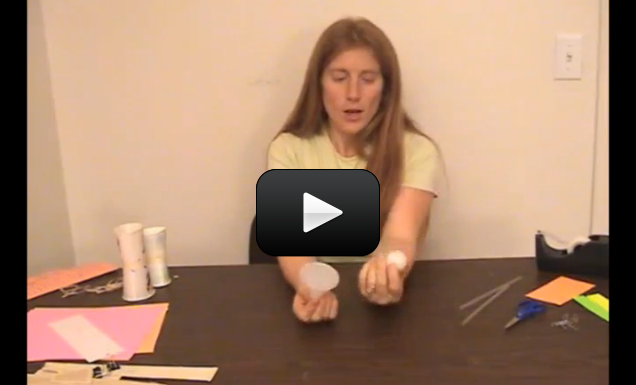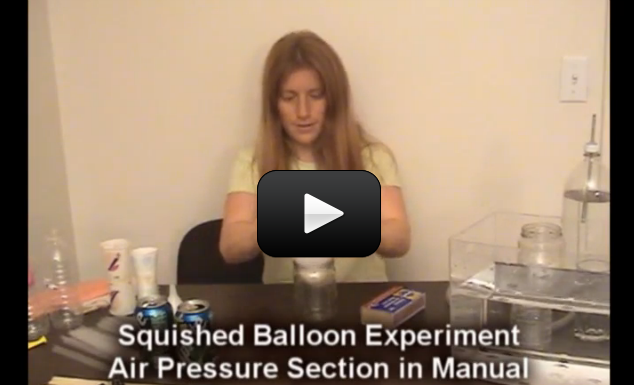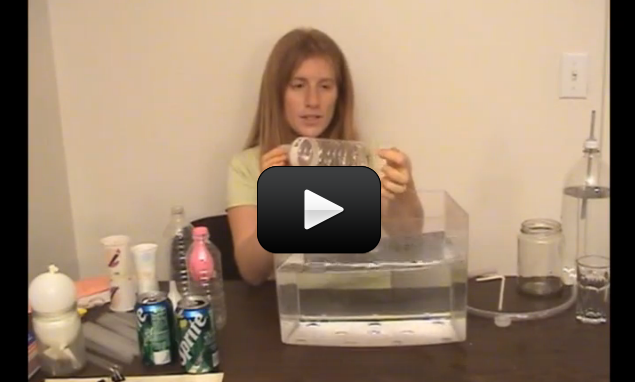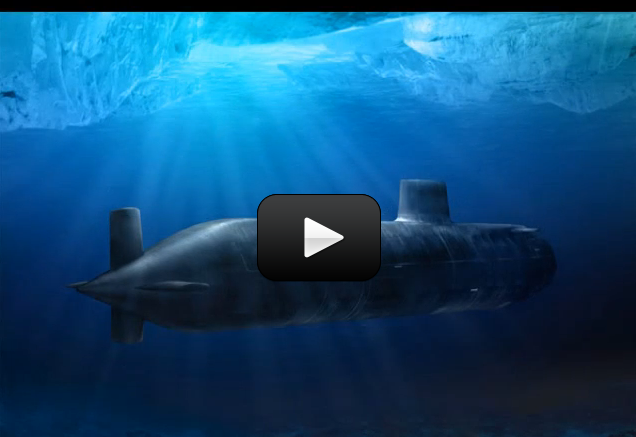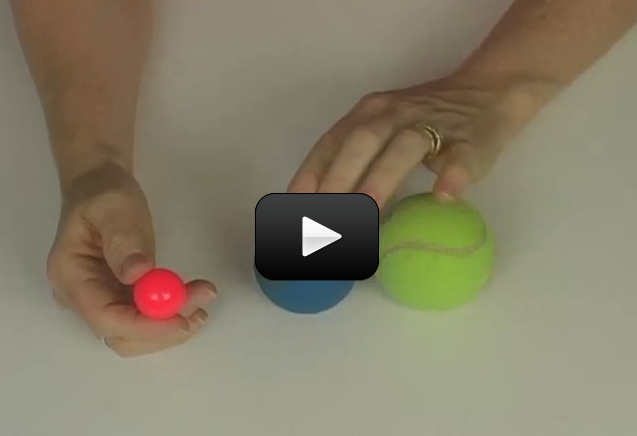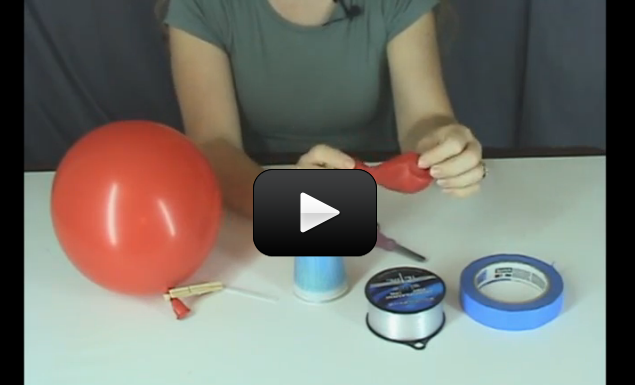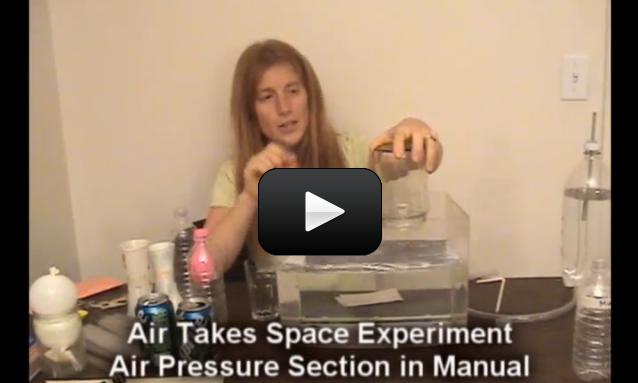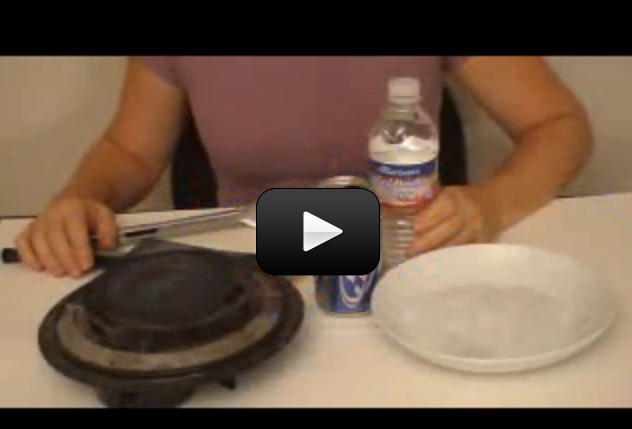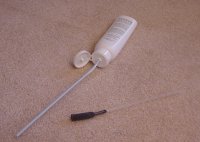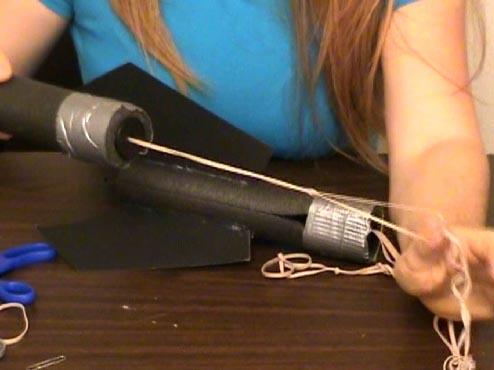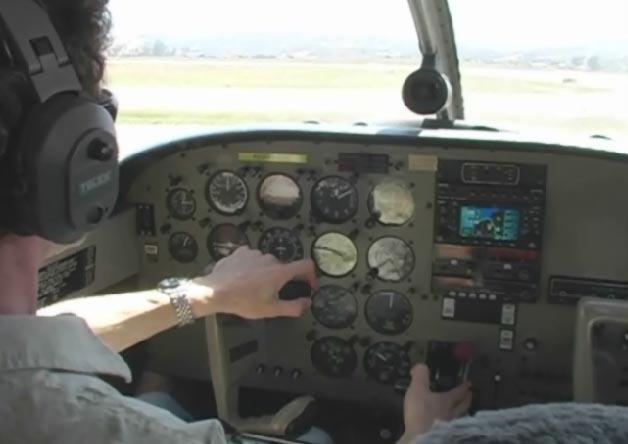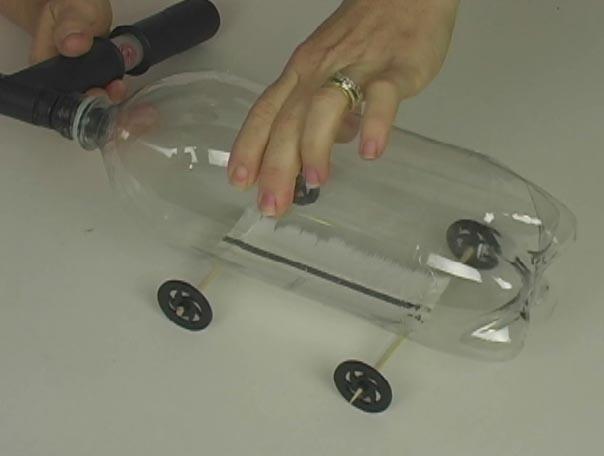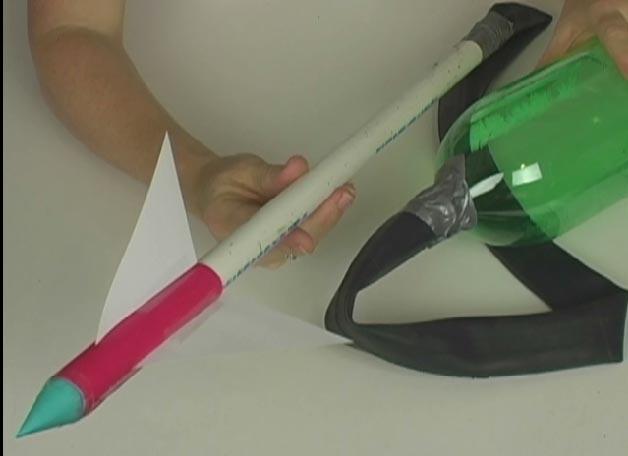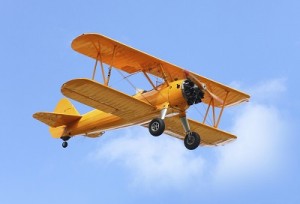 Click here for a printer-friendly version of this page.
Click here for a printer-friendly version of this page.
Objective You’re going to do several experiments that change air pressure and mystify your kids. The goal is to set them thinking about how and why things fly (you’ll do this by learning about air pressure and Bernoulli’s law, but you don’t need to tell them that). The first thing to do is watch the video below and then dive into the experiments.
Main Ideas While the kids are playing with the experiments see if you can get them to notice these important ideas. When they can explain these concepts back to you (in their own words or with demonstrations), you’ll know that they’ve mastered the lesson.
- Air pressure is all around us. Air pushes downward and creates pressure on all things.
- Air pressure changes all the time.
- Higher pressure always pushes.
- The faster air travels over a surface, the less time it has to push down on that surface and create pressure. Fast moving air creates low pressure regions. (Bernoulli’s Law).
- The four fundamental forces on an airplane are lift, weight, thrust, and drag.
About the Experiments There are a lot of experiments in this section that will hone your child’s observation skills. About half the experiments are on flying machines and the other half consist of air pressure demonstrations. When their airplane doesn’t work right, ask them what exactly it’s doing (or not doing), and then take a more careful look at how it’s constructed. Focus on watching what happens when you make small changes, and try to change only one thing at a time.
The How and Why Explanation There’s air surrounding us everywhere, all at the same pressure of 14.7 pounds per square inch (psi). You feel the same force on your skin whether you’re on the ceiling or the floor, under the bed or in the shower.
An interesting thing happens when you change a pocket of air pressure – things start to move. This difference in pressure causes movement that creates winds, tornadoes, airplanes to fly, and some of the experiments we’re about to do together.
An important thing to remember is that higher pressure always pushes stuff around. While lower pressure does not “pull,” we think of higher pressure as a “push”. The higher pressure inside a balloon pushes outward and keeps the balloon in a round shape.
Weird stuff happens with fast-moving air particles. When air moves quickly, it doesn’t have time to push on a nearby surface, such as an airplane wing. The air just zooms by, barely having time to touch the surface, so not much air weight gets put on the surface. Less weight means less force on the area. You can think of “pressure” as force on a given area or surface. Therefore, a less or lower pressure region occurs wherever there is fast air movement.
There’s a reason airplane wings are rounded on top and flat on the bottom. The rounded top wing surface makes the air rush by faster than if it were flat. When you put your thumb over the end of a gardening hose, the water comes out faster when you decrease the size of the opening. The same thing happens to the air above the wing: the wind rushing by the wing has less space now that the wing is curved, so it zips over the wing faster, and creates a lower pressure area than the air at the bottom of the wing.
The Wright brothers figured how to keep an airplane stable in flight by trying out a new idea, watching it carefully, and changing only one thing at a time to improve it. One of their biggest problems was finding a method for generating enough speed to get off the ground. They also took an airfoil (a fancy word for “airplane wing”), turned it sideways, and rotated it around quickly to produce the first real propeller that could generate an efficient amount of thrust to fly an aircraft. Before the Wright brothers perfected the airfoil, people had been using the same “screw” design created by Archimedes in 250 BC. This twist in the propeller was such a superior design that modern propellers are only 5% more efficient than those created a hundred years ago by the two brilliant Wright brothers.
Questions to Ask When you’ve worked through most of the experiments ask your kids these questions and see how they do:
- Higher pressure does which? (a) pushes (b) pulls (c) decreases temperature (d) meows (e) causes winds, storms, and airplanes to fly
- The tips on the edge of a paper airplane wing provide more lift by: (a) flapping a lot
(b) destroying wingtip vortices that kill lift (c) getting stuck in a tree more easily (d) decreasing speed - In the ping pong ball and funnel experiment, the ball stayed in the funnel was because: (a) you couldn’t blow hard enough (b) you glued it into the funnel (c) the ball had a hole in it (d) the fast blowing caused a low-pressure region around the ball, causing the surrounding atmospheric pressure to be a higher pressure, thus pushing the ball into the funnel
- In the sneaky bottle experiment, which of the two bottles was the balloon able to inflate in? (a) the one with a hole (b) the one with no holes (c) the one the kid fit inside
- If your plane takes a nose dive, you should try (a) changing the elevators by pinching the edges (b) change the dihedral angle (c) change how you throw it (d) all of the above
- What are the four forces that act on every airplane in flight?
- Draw a quick sketch of your plane viewed from the front with a positive dihedral.
- Why does the index card stay in place when you invert the cup of water in the magic water glass trick?
- When the balloon was squished into the jam jar with the snuffed candle, where was the higher pressure?
10. Why does the water stop streaming out of the bottle when you put the cap on in the streaming water experiment? Why does the water come out if you squeeze the capped bottle?
11. How can you make the fountain bottle shoot even higher?
12. If you were designing your own “Flying Paper Machine Kit”, what would be inside the box?
13. What’s the one thing you need to remember about higher pressure?
14. What keep an airplane from falling?
15. Where is the low pressure area on an airplane wing?
How many of these items do you already have? We’ve tried to keep it simple for you by making the majority of the items things most people have within reach (both physically and budget-wise).
You do not need to do ALL the experiments – just pick the ones you want to do! Look over the experiments and note which items are needed, and off you go!
Click here for a printer-friendly version of this page.
Materials
Materials
- Water
- Bathtub or sink
- Bowl
- Scrap of paper towel
- 2 clear cups
- 25 straws
- Small lump of clay
- 3 balloons
- 2 thumbtacks
- Plastic funnel
- Ping pong ball
- Plastic garbage bag
- Red and blue food coloring
- 20 sheets of 8 ½” x 11” paper
- Pencil
- Rubber band
- Popsicle stick
- 2 small paper clips
- 2 identical water glasses
- 10 index cards (large enough to cover the mouth of the water glass)
- 3 empty soda cans
- Empty glass jar
- Empty 2-liter soda bottle
- 2 empty water bottles
- 12” flexible tubing (or use a flexible straw)
- Matches with adult help
- Test tube
- 2-liter soda bottle
Tools
- Scissors
- Tongs
- Tape
- Duct tape
- Hair dryer
- Stove with adult help
Optional
The projects that require these items are either more expensive or harder to build and require adult help. Watch the videos before shopping for these items!
- Page from a phone book
- Scrap piece of cardboard (2’x3′)
- 1 wood pencil with eraser
- AA battery pack
- 3VDC motor
- 5 popsicle sticks
- 2 alligator clip leads
- AA batteries for your battery case (Cheap dollar-store “heavy duty” type are perfect. Do NOT use alkaline batteries like Duracell or Energizer!)
- 1 propeller (rip this off an old toy or hand-held fan or balsa wood airplane)
- Diaper Genie II Refill Pack
Please login or register to read the rest of this content.
Materials: Index card, straw, scissors, tape.
Please login or register to read the rest of this content.
Please login or register to read the rest of this content.
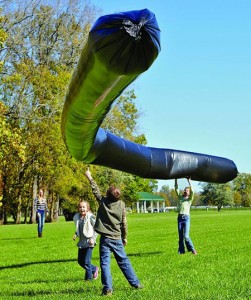 We didn't include this particular experiment in our shopping list, as the tube's kind of expensive and can only be used for one particular experiment, BUT it's an incredible blast to do in the summer.
We didn't include this particular experiment in our shopping list, as the tube's kind of expensive and can only be used for one particular experiment, BUT it's an incredible blast to do in the summer.
Here's the main idea - an incredibly loooooong and super-lightweight black plastic garbage bag is filled with air and allowed to heat itself in the sun. In a few short minutes, the entire 60-foot tube tube rises into the air. Before you try this experiment, try the Hot Air Balloon first!
Order the Solar Tube here.
This is another favorite of mine - you can fold this one in under two minutes. Make sure you tweak your airplane to get it to fly just the way you want.
If you don't have access to an air compressor or air tank with a spray-nozzle, you can either make your own rocket launcher (watch second video below), or make the blow-gun rockets. Either way, you're going to be launching sky-high in no time!
Materials:
- Two straws each in two different sizes
- two sheets
- index cards
- scissors
- tape
- hot glue gun
- air compressor or air tank with spray-nozzle
- metal tubing that fits just inside the larger straws
Every flying thing, whether it's an airplane, spacecraft, soccer ball, or flying kid, experiences four aerodynamic forces: lift, weight, thrust, and drag. An airplane uses a propeller or jet engine to generate thrust. The wings create lift. The smooth, pencil-thin shape minimizes drag. And the molecules that make up the airplane attribute to the weight.
Think of a time when you were riding in a fast-moving car. Imagine rolling down the window and sticking out your hand, palm down. The wind slips over your hand. Suppose you turn your palm to face the horizon. In which position do you think you would feel more force against your hand?
When designing airplanes, engineers pay attention to details, such as the position of two important points: the center of gravity and the center of pressure (also called the center of lift). On an airplane, if the center of gravity and center of pressure points are reversed, the aircraft’s flight is unstable and it will somersault into chaos. The same is true for rockets and missiles!
How to Build an Airplane
Materials: balsa wood flyer
This video shows how to use a balsa airplane to show what all the parts (rudder, wings, elevator, fuselage) are for. You can pick one up for a few dollars, usually at a toy store, or make your own (see second video below).
Please login or register to read the rest of this content.
 Click here for a printer-friendly version of this page.
Click here for a printer-friendly version of this page.
Objective You’re going to build on the Flying Machines concepts by building larger airfoils called Kites. The goal is to get them even more excited about fluid mechanics and aerodynamics by building projects that really fly. We’re going to continue learning about air pressure and Bernoulli’s law through the different kite designs. The first thing to do is watch the video on the Kites website page, and then dive into the experiments.
Main Ideas While the kids are playing with the experiments see if you can get them to notice these important ideas. When they can explain these concepts back to you (in their own words or with demonstrations), you’ll know that they’ve mastered the lesson.
- Higher pressure always pushes.
- The faster air travels over a surface, the less time it has to push down on that surface and create pressure. Fast moving air creates low pressure regions. (Bernoulli’s Law).
- The four fundamental forces on a kite are lift, weight, thrust, and drag. (The thrust is the pull on the string, and the lift occurs when wind flows over the top and bottom of the kite.)
About the Experiments The experiments in this section will take more time to put together, as you are building several different kite designs, including the box kite, the dragon, the diamond, and the rotor kite. If your kite doesn’t take off immediately, ask your child how it doesn’t work… did the nose tip over, did it spin, flip, or just tumble? Asking better questions is one of the key ingredients to making a great a scientist. Focus on watching what happens when you make small changes, and try to change only one thing at a time.
Before flight, hold your kite where the main line attaches to the bridle (the part that attaches to the string spool). Adjust the strings so that the kite hangs about 30 degrees into the wind. Use your fingers on the bridle on a windy day to find the “magic spot” or the place where your kite picks right up and flies best.
Moving the bridle forward makes the kite fly higher in smooth winds and moving it backward helps it fly in gusty winds. If your kite fails to rise, try a windier spot or a shorter tail. If it flies then quickly crashes, you may need to shorten your bridle or change the angle. If your kite spins around and around while flying, add more tail length.
The How and Why Explanation Kites are airplanes on a string. They use both high and low pressure to gain altitude and soar skyward. Not all kites need tails—the tail section helps stabilize an otherwise unstable kite design by adding a bit of weight near the bottom. While kites need to be lightweight, the framework needs to be strong, as they can withstand winds greater than 70 mph at higher altitudes.
To launch a kite, you can start with it on the ground and simply start running, hold it in your hands and toss it behind you as you run, or have someone hold it for you and toss it up as you start to run with the string. The best launch method depends on the kind of kite you’re working with. For example, the Bat Kite just needs to be tossed into the air with a kid running in front of it, while the rotor kite is going to require a windy day or a bicycle.
Questions to Ask When you’ve worked through most of the experiments ask your kids these questions and see how they do:
1. Kites need string so: (a) they don’t get lost (b) to hold them at the correct angle to the wind (c) so you can pull the kite in when you’re done (d) all the above
2. Kites can be in the shape of which ones? (a) box (b) pyramid (c) diamond (d) hippos
3. Which part of the kite is the most adjustable? (a) the kite skin (b) the tail (c) the bridle (d) the frame
4. Which kite is collapsible and easy to carry? (a) sled (b) dragon (c) bat (d) rotor (e) tetrahedral (f) diamond
5. If your kite crashes to the ground, what two things can you try changing?
6. How do you get your kite to spin in circles?
7. How much wind does the Rotor kite need? (a) a day at the beach could work (b) zero (c) winds like a hurricane (d) running ought to do it
8. What do you do if your kite doesn’t lift off the ground? (a) run faster (b) find a windier spot (c) let go of the kite (d) stop stepping on it (e) all of the above
9. Where is the higher pressure area on the kite during flight? (a) the topside (b) the underside (c) the tail (d) nowhere
10. What is the frame for on a kite? (a) to keep the kite in the right shape (b) to provide weight in the right places (c) so it can break (d) so you have something to attach the bridle to
11. Which kite works with the least amount of wind?
This kite is sometimes referred to as a "Comet Kite", as it has a main head area and a loooong tail section. We recommend making the kite from lightweight garbage bags, as they tend to hold up better than tissue paper, and don't require sewing they way ripstop nylon material does.
Here's what you need to get: Wire coat hanger or thin plastic dowel, string, straw, plastic garbage bags, tape, and scissors.
Here's what you do:
Please login or register to read the rest of this content.
How many of these items do you already have? We’ve tried to keep it simple for you by making the majority of the items things most people have within reach (both physically and budget-wise).
You do not need to do ALL the experiments – just pick the ones you want to do! Look over the experiments and note which items are needed, and off you go!
Click here for a printer-friendly version of this page.
Materials
- 11”x17” sheet of paper (or tape two 8 ½” x 11” to make this size)
- A big roll of string (enough for six kites)
- 20 donut stickers (also known as page reinforcement stickers)
- 50 straws
- 4 sheets of tissue paper
- 10-20’ crepe paper streamer for kite tail
- 3 wire coat hangers or 36” balloon sticks (these are a better choice if you can find them)
- Five plastic garbage bags
- 2 foam plates (at least 4 inches in diameter)
- 6”x4” clean foam meat tray
Tools
- Stapler
- Tape
- Scissors
- Hot glue gun with glue sticks
- Glue sticks (the retractable kind)
- Duct tape
How many of these items do you already have? We’ve tried to keep it simple for you by making the majority of the items things most people have within reach (both physically and budget-wise).
You do not need to do ALL the experiments – just pick the ones you want to do! Look over the experiments and note which items are needed, and off you go!
Click here for a printer-friendly version of this page.
Materials
- 10 sheets of 8×11” paper
- 5 index cards
- 7-9” latex balloon
- 15 large straws
- 5 small straws (make sure these slide easily into the larger straws)
- wooden spring-type clothespin
- 4 popsicle sticks (any size)
- 5 skewers
- 8 milk jug lids, film tops, or other small, plastic lids that are round for wheels
- 6” long piece of 3/4” foam pipe insulation
- foam sheet from a craft store
- 4 Fuji film canisters or plastic M&M containers (check recycle bin at a photo developing store)
- 2 small paper clips
- 8 rubber bands
- effervescent tablets (generic alka seltzer works great)
- clean, empty shampoo or lotion bottle
- small piece of squishy foam or packing peanut
- wood skewer (should fit inside straws)
- bike pump
- needle valve
- neoprene stopper that fits a 2L soda bottle
- empty 2-liter soda bottles
Tools
- duct tape
- scissors
- tape
- hot glue gun
Optional Materials: These rockets go a lot further, but also require adult help to create or are more expensive to build. Watch the video first before starting these projects!
- razor blade
- vice or vice grips
- drill with ½” drill bit (spade bit is best)
- air compressor and/or air tank
- spray-nozzle for compressor/tank
- 3 foot piece of metal tubing that fits just inside the larger straws (listed above)
- car tire valve (find this at a tire repair shop)
- 2 to 5 empty 2-liter soda bottles with caps
- 5 ball bearings , ½” diameter
- 4 neodymium (super-strong) magnets (1/2″ cube)
- paper towel tube
- 1 inch wide bike tube (at least 3 feet long)
- 12” long x 1/2” diameter PVC pipe
 Click here for a printer-friendly version of this page.
Click here for a printer-friendly version of this page.
Objective Kids love going fast and blowing things skyward. This set of experiments should satisfy both needs. The goal is to not only provide them with a safe set of activities that will keep their eyebrows intact, but also to get them really excited about aerodynamics and rocket design by building projects that really work. Most rockets will require a certain amount of tweaking (like the Flying Machines experiments did) in order to fly straight. This is an excellent time to hone their observation skills and get them into the habit of changing and testing only one thing at a time.
We’re going to continue learning about pressure as we generate high pressure through both bicycle pumps as well as chemical reactions. The first thing to do is watch the video on the Rocketry website page, and then dive into the experiments.
Main Ideas While the kids are playing with the experiments see if you can get them to notice these important ideas. When they can explain these concepts back to you (in their own words or with demonstrations), you’ll know that they’ve mastered the lesson.
- For every action, there is an equal and opposite reaction.
- The position of the center of pressure relative to the center of gravity of a rocket determines how stable the flight will be.
About the Experiments The experiments in this section vary from small indoor flights to rockets that go over a football field in distance. All rockets move by a quick release in pressure. Once your rocket takes flight, take a clear look (or better, a video so you can watch it a few times over) at how it flies when it’s up there. By launching at an angle instead of straight up, you’ll get a better view… just be sure your launch area is clear.
Stability of Flight: A rocket has two key points (CP & CG, covered in the Flying Machines experiments) that you need to know in order to have stable flight. Here’s how you find and adjust them:
- Finding the Center of Pressure: You can find center of pressure by tying a string around the rocket body and swinging it around your head. The balance point is your center of pressure. Mark the point as CP.
- Finding the Center of Gravity: Balance your rocket on a pencil tip. Mark the point as CG. Note if this is forward or aft of your CP.
- To adjust the CG/CP: It’s easier to adjust the CG – add weight to the nose or more fins to the tail section. Re-measure your CG when you’re done.
- Read more about rocket stability here.
The How and Why Explanation Rockets shoot skyward with massive amounts of thrust, produced by chemical reaction or air pressure. Scientists create the thrust force by shoving a lot of gas (either air itself, or the gas left over from the combustion of a propellant) out small exit nozzles.
According to the universal laws of motion, for every action, there is equal and opposite reaction. If flames shoot out of the rocket downwards, the rocket itself will soar upwards. It’s the same thing if you blow up a balloon and let it go—the air inside the balloon goes to the left, and the balloon zips off to the right (at least, initially, until the balloon neck turns into a thrust-vectored nozzle, but don’t be concerned about that just now).
A rocket has a few parts different from an airplane. One of the main differences is the absence of wings. Rockets utilize fins, which help steer the rocket, while airplanes use wings to generate lift. Rocket fins are more like the rudder of an airplane than the wings.
Another difference is the how rockets get their speed. Airplanes generate thrust from a rotating blade, whereas rockets get their movement by squeezing down a high-energy gaseous flow and squeezing it out a tiny exit hole.
If you’ve ever used a garden hose, you already know how to make the water stream out faster by placing your thumb over the end of the hose. You’re decreasing the amount of area the water has to exit the hose, but there’s still the same amount of water flowing out, so the water compensates by increasing its velocity. This is the secret to converging rocket nozzles—squeeze the flow down and out a small exit hole to increase velocity.
The rockets we’re about to build get their thrust by generating enough pressure and releasing that pressure very quickly. You will generate pressure both by pumping and by chemical reaction, which generates gaseous products. Let’s get started!
Questions to Ask When you’ve worked through most of the experiments ask your kids these questions and see how they do:
- If you inflate a balloon (don’t tie the end), which direction does the air in the balloon and the balloon itself travel? (a) both the same way (b) in opposite directions (c) nothing happens
- When you drop an effervescent tablet into water, what happens? (a) bubbles foam up (b) it burps (c) carbon dioxide gas is released (d) it produces a chemical reaction that can propel a rocket skyward
- Puff Rockets use which of the following propellants? (a) air pressure (b) chemical reactions (c) both (d) neither
- The most dangerous parts of the Water Rocket experiment is are: (a) working with high pressure (b) that you’ve stripped out the threads that normally secure the cap in place, and now it’s easier to accidentally release the rocket and shoot someone’s eyeballs out (c) reusing the bottles over and over causes fissures and cracks to form in the bottle, increasing the chances of bursting if you don’t replace the bottle after every 7-10 launches (d) all of the above and more
- The most important things to remember when launching water rockets are: (a) safety goggles or face shield (b) 70 psi maximum air pressure (c) always hold the valve-side down when holding the bottle (d) only use soda bottles that are build to hold pressure (e) never water bottles, juice bottles, sports drink bottles, or any others that don’t say pssssst! when you first open them
- To get the multi-staging rockets to work correctly, where does the trigger need to be? (a) inside the first balloon (b) on the string (c) in the straw (d) squished between the first balloon and the cup
- How does a Slingshot Rocket work? Where does the thrust come from?
- If your Blow Gun Rocket straw rips loose, what can you do to quickly repair it without rebuilding the entire rocket?
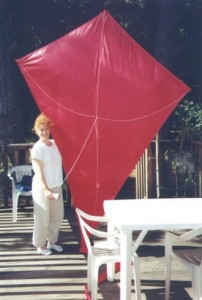 Did you notice how BIG these kites can get? And yes, that's me in the photo, at full size!
Did you notice how BIG these kites can get? And yes, that's me in the photo, at full size!
If you're looking for a kite that will lift you off your feet, THIS IS THE ONE! I'm going to show you how to build a smaller version first, so you get the hang of how it goes together.
Afterward, you can make a 6-foot, 9-foot, or 12-foot model. Just keep your proportions right and find strong, lightweight materials (bamboo is a popular choice, but watch the wall-thickness or it too can get heavy).
The photo here is the 9-foot tall version of this kite, which sports a 25-foot tail. To fly this, you'll need a lot of wind, so if you live near the beach, you might be able to get this up. Otherwise, you can try to get it airborne by doing what I used to do with mine - tie it to the bumper of your pickup truck and drive out in the country with about a mile of strong string!
The 6-foot versions in a strong wind will generate enough to lift small kids, so watch out (and get your camera).
If you can find balloon sticks (white plastic stiff tubes about 3 feet long), use them. They’re inexpensive, lightweight, and easy to work with. Otherwise, use wood dowels from a hardware store or 36” bamboo gardening stakes from a nursery.
 Did you notice how BIG these kites can get? And yes, that's me in the photo, at full size!
Did you notice how BIG these kites can get? And yes, that's me in the photo, at full size!
If you're looking for a kite that will lift you off your feet, THIS IS THE ONE! I'm going to show you how to build a smaller version first, so you get the hang of how it goes together.
Afterward, you can make a 6-foot, 9-foot, or 12-foot model. Just keep your proportions right and find strong, lightweight materials (bamboo is a popular choice, but watch the wall-thickness or it too can get heavy).
The photo here is the 9-foot tall version of this kite, which sports a 25-foot tail. To fly this, you'll need a lot of wind, so if you live near the beach, you might be able to get this up. Otherwise, you can try to get it airborne by doing what I used to do with mine - tie it to the bumper of your pickup truck and drive out in the country with about a mile of strong string!
The 6-foot versions in a strong wind will generate enough to lift small kids, so watch out (and get your camera).
If you can find balloon sticks (white plastic stiff tubes about 3 feet long), use them. They’re inexpensive, lightweight, and easy to work with. Otherwise, use wood dowels from a hardware store or 36” bamboo gardening stakes from a nursery.
In fact, each time it flies well, I'll take a measurement and so pretty soon my plane has a data table under the wing. This way, I know which plane to choose in a race!
Please login or register to read the rest of this content.
Please login or register to read the rest of this content.
A rocket has a few parts different from an airplane. One of the main differences is the absence of wings. Rockets utilize fins, which help steer the rocket, while airplanes use wings to generate lift. Rocket fins are more like the rudder of an airplane than the wings. A fighter plane is like a cross between a rocket and an airplane, because of the high amount of thrust generated by the engines.
A pulse jet engine is something students make in college engineering courses under the direction of experienced professors. When I was a student, we made a small Pulse Jet Engine out of clear acrylic that burned bright and loud enough to wear eye and hearing protection.
These types of engines are very simple, as they have no moving parts. They've been used on scram jet engines and other types of supersonic craft. A pulsejet engine works by alternately pushing out a hot breath of air rearward and then breathing in fresh air to replace it. They can run on gasoline, diesel, or kerosene.
The video below is for DEMONSTRATION PURPOSES ONLY. Please read text below the video.
Rockets shoot skyward with massive amounts of thrust, produced by chemical reaction or air pressure. Scientists create the thrust force by shoving a lot of gas (either air itself, or the gas left over from the combustion of a propellant) out small exit nozzles.
According to the universal laws of motion, for every action, there is equal and opposite reaction. If flames shoot out of the rocket downwards, the rocket itself will soar upwards. It’s the same thing if you blow up a balloon and let it go—the air inside the balloon goes to the left, and the balloon zips off to the right (at least, initially, until the balloon neck turns into a thrust-vectored nozzle, but don’t be concerned about that just now).
A rocket has a few parts different from an airplane. One of the main differences is the absence of wings. Rockets utilize fins, which help steer the rocket, while airplanes use wings to generate lift. Rocket fins are more like the rudder of an airplane than the wings.
Another difference is the how rockets get their speed. Airplanes generate thrust from a rotating blade, whereas rockets get their movement by squeezing down a high-energy gaseous flow and squeezing it out a tiny exit hole.
If you’ve ever used a garden hose, you already know how to make the water stream out faster by placing your thumb over the end of the hose. You’re decreasing the amount of area the water has to exit the hose, but there’s still the same amount of water flowing out, so the water compensates by increasing its velocity. This is the secret to converging rocket nozzles—squeeze the flow down and out a small exit hole to increase velocity.
There comes a point, however, when you can’t get any more speed out of the gas, no matter how much you squeeze it down. This is called “choking” the flow. When you get to this point, the gas is traveling at the speed of sound (around 700 mph, or Mach 1). Scientists found that if they gradually un-squeeze the flow in this choked state, the flow speed actually continues to increase. This is how we get rockets to move at supersonic speeds or above Mach 1.
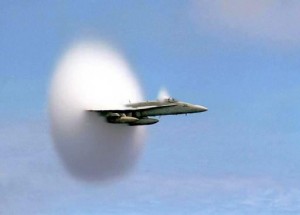 The image shown here is a real picture of an aircraft as it breaks the sound barrier. This aircraft is passing the speed at which sounds travel. The white cloud you see in the photo is related to the shock waves that are forming around the craft as it moves into supersonic speeds. Because the aircraft is moving through air, which is a gas, the gas can compress and results in a shock wave.
The image shown here is a real picture of an aircraft as it breaks the sound barrier. This aircraft is passing the speed at which sounds travel. The white cloud you see in the photo is related to the shock waves that are forming around the craft as it moves into supersonic speeds. Because the aircraft is moving through air, which is a gas, the gas can compress and results in a shock wave.
You can think of a shock wave as big pressure front. In this photo, the pressure is condensing water vapor in the air, hence the cloud. There are lots of things on earth that break the sound barrier – bullets and bullwhips, for example. The loud crack from a whip is the tip zipping faster than the speed of sound.
The rockets we're about to build get their thrust by generating enough pressure and releasing that pressure very quickly. You will generate pressure both by pumping and by chemical reaction, which generates gaseous products. Let's get started!
For this experiment, you will need:
-
- sheet of paper
-
- hair dryer
-
- pencil with a sharp tip
Let's make another favorite flyer of mine...
Please login or register to read the rest of this content.
Let’s find the center of gravity on your airplane. Grab your flying machine and sharpened pencil. You can find the ‘center of gravity’ by balancing your airplane on the tip of a pencil. Label this point “CG” for Center of Gravity.
Materials:
- sheet of paper
- hair dryer
- pencil with a sharp tip
We're going to make a paper airplane first, and then do a couple of wind tunnel tests on it.
For the project, all you need is a sheet of paper and five minutes... this is one my favorite fliers that we make with our students!
Find the Center of Pressure (CP) by doing the opposite: Using a blow-dryer set to low-heat so you don’t scorch your airplane, blast a jet of air up toward the ceiling. Put your airplane in the air jet and, using a pencil tip on the top side of your plane, find the point at which the airplane balances while in the airstream. Label this point “CP” for Center of Pressure. (Which one is closest to the nose?)
Besides paying attention to the CG and CP points, aeronautical engineers need to figure out the static and dynamic stability of an airplane, which is a complicated way of determining whether it will fly straight or oscillate out of control during flight. Think of a real airplane and pretend you’ve got one balanced on your finger. Where does it balance? Airplanes typically balance around the wings (the CG point). Ever wonder why the engines are at the front of small airplanes? The engine is the heaviest part of the plane, and engineers use this weight for balance, because the tail (elevator) is actually an upside-down wing that pushes the tail section down during flight.
This project is simple, yet highly satisfying. The current record distance traveled is 74 feet... can you beat that? Make sure you launch these UP, not horizontally! You only need three items, all of which are in your house right now! First, you need a piece of...
This project is simple, yet highly satisfying. The current record distance traveled is 74 feet... can you beat that? Make sure you launch these UP, not horizontally! You only need three items, all of which are in your house right now! First, you need a piece of...
Rockets shoot skyward with massive amounts of thrust, produced by chemical reaction or air pressure. Scientists create the thrust force by shoving a lot of gas (either air itself, or the gas left over from the combustion of a propellant) out small exit holes out the back of the nozzles.
Here are two videos of real rockets being tested. The second video uses a special type of photography to see the shock waves (you will learn more about how that's done in Unit 9).
For every action, there is equal and opposite reaction. If flames shoot out of the rocket downwards, the rocket itself will soar upwards. It’s the same thing if you blow up a balloon and let it go—the air inside the balloon goes to the left, and the balloon zips off to the right. They both follow Newton's Third Law: for every action, there is an equal and opposite reaction.
What you're looking at in the video below is exactly the kind of work I did as a graduate student in college when I was 21. The end of a rocket nozzle is on the right side, and you're looking at supersonic air (made visible by a special type of photography called 'Schlieren') as a rushes past from right to left. The thick white lines are shock waves, which are lines where the pressure drop is huge. When the flow is fast enough (around Mach 2 and up), you'll see nicely shaped 'Mach Diamonds' form.
Scientists use these images to tell how well the engines will perform at high-speed flight. One of the greatest aeronautical engineers, Kelly Johnson, who founded Skunkworks at Lockheed, said the greatest compliment he ever received was when a friend commented: "It's amazing... he can actually see airflow." This is what Johnson could visualize in his mind simply because he understood the fundamentals of aerodynamics:
- clean lotion bottle or shampoo bottle
- larger straw that fits onto a smaller straw
- small piece of foam that fits snugly into the straws
- hot glue gun
Rotor kites (often called UFO kites) are one of those unusual kites that require more complex aerodynamics in order to fly. This particular kite flies only when rotating. Make sure you have lots of wind for this kite by either visiting the beach or tying it to your bicycle.
This kite is very picky about wind speed. Make sure the string doesn’t rub on the plates during flight. You can use hollow gardening stakes, empty ballpoint pen tubes taped together into a long straw, or composite tubes instead of the straws described here. Fishing line or nylon string works for kite line as well.
Materials: Two straws, a long length of string (20 feet or more), duct tape, two foam plates (at least 4 inches in diameter, one 6x4-inch clean foam meat tray, hot glue gun, and scissors.
Here's what you do:
Rotor kites (often called UFO kites) are one of those unusual kites that require more complex aerodynamics in order to fly. This particular kite flies only when rotating. Make sure you have lots of wind for this kite by either visiting the beach or tying it to your bicycle.
This kite is very picky about wind speed. Make sure the string doesn’t rub on the plates during flight. You can use hollow gardening stakes, empty ballpoint pen tubes taped together into a long straw, or composite tubes instead of the straws described here. Fishing line or nylon string works for kite line as well.
Materials: Two straws, a long length of string (20 feet or more), duct tape, two foam plates (at least 4 inches in diameter, one 6x4-inch clean foam meat tray, hot glue gun, and scissors.
Here's what you do:
Please login or register to read the rest of this content.
This is such a cool project that I had to include it in our Flying Machines archive. The science teacher who developed this project has a sincere love of gliders he calls “walk-along flyers”. Note that the instructions for making this project are longer and more precise than usual, so take your time and go slow.
If your kids love airplanes, you’ll be able to keep them busy for hours with this project! You will be flying a piece of paper, surfing it on a wave of air created with cardboard. Are you ready? There are two different designs to choose from: the Tumblewing, which works by rotation, and the Hanglider.
Here’s what you need:
- piece of paper from a phone book
- scrap of cardboard
- scissors
- help from a very patient adult
- an afternoon (this project is super-sensitive and you need time and persistence to accomplish it!)
Tumblewing Design
You’ll need to print out this Tumblewing template to get started.
Hanglider Design:
You’ll need to print out this Hanglider template to get started.
A big THANKS goes out to projects developer and science teacher Slater Harrison for his ultra-cool flying inventions!
Please login or register to read the rest of this content.
Please login or register to read the rest of this content.
 We’ve included several flying designs for you to test, including: stunt planes, fast jets, hang gliders, and a one that, mathematically-speaking, isn’t even supposed to fly.
We’ve included several flying designs for you to test, including: stunt planes, fast jets, hang gliders, and a one that, mathematically-speaking, isn’t even supposed to fly.The trick to any paper airplane, be it a dart, stunt, or glider, is in the tweaking. In order to turn a disappointing nose-diver into a stellar barrel-roller, you’ll need to pay close attention to your dihedral angle (angle the wings make with the horizon) and elevator angle (pinching up or down to the tail section).
Here’s how we do it:
Please login or register to read the rest of this content.
I carried one of these kites in my backpack in grade school, as it collapses down very small when not in use. You can make smaller versions from still paper, but the one we're going to do uses plastic.
Here's what you need to get:
Two 24 inch wood dowels (or two 24 inch long plastic balloon sticks), four donut stickers (also known as page reinforcement stickers), string, plastic garbage bags, tape and scissors.
I carried one of these kites in my backpack in grade school, as it collapses down very small when not in use. You can make smaller versions from still paper, but the one we're going to do uses plastic.
Here's what you need to get:
Two 24 inch wood dowels (or two 24 inch long plastic balloon sticks), four donut stickers (also known as page reinforcement stickers), string, plastic garbage bags, tape and scissors.
Please login or register to read the rest of this content.
Both of these contraptions fly well if you take your time and make them carefully. Just watch yourself with the ninja star - it's not only fast and furious, the ends are sharp and guaranteed to turn heads... and necks.
Please login or register to read the rest of this content.
When air moves, the air pressure decreases. This creates a lower air pressure pocket right between the cans relative to the surrounding air. Because higher pressure pushes, the cans clink together. Just remember – whenever there’s a difference in pressure, the higher pressure pushes.
You will need about 25 straws and two empty soda cans or other lightweight containers
Please login or register to read the rest of this content.
While this isn’t actually an air-pressure experiment but more of an activity in density, really, it’s still a great visual demonstration of why Hot Air Balloons rise on cold mornings.
Imagine a glass of hot water and a glass of cold water sitting on a table, side by side. Now imagine you have a way to count the number of water molecules in each glass. Which glass has more water molecules?
The glass of cold water has way more molecules… but why? The cold water is more dense than the hot water. Warmer stuff tends to rise because it’s less dense than colder stuff and that’s why the hot air balloon in experiment 1.10 floated up to the sky.
Clouds form as warm air carrying moisture rises within cooler air. As the warm, wet air rises, it cools and begins to condense, releasing energy that keeps the air warmer than its surroundings. Therefore, it continues to rise. Sometimes, in places like Florida, this process continues long enough for thunderclouds to form. Let’s do an experiment to better visualize this idea.
Please login or register to read the rest of this content.
Lots of science toy companies will sell you this experiment, but why not make your own? You’ll need to find a loooooong bag, which is why we recommend a diaper genie. A diaper genie is a 25′ long plastic bag, only both ends are open so it’s more like a tube. You can get three 8-foot bags out of one pack.
Kids have a tendency to shove the bag right up to their face and blow, cutting off the air flow from the surrounding air into the bag. When they figure out this experiment and perform it correctly, this is one of those oooh-ahhh experiments that will leave your kids with eyes as big as dinner plates.
Here’s what you do:
Please login or register to read the rest of this content.
About 400 years ago, Leonardo da Vinci wanted to fly… so he studied the only flying things around at that time: birds and insects. Then he did what any normal kid would do—he drew pictures of flying machines!
Centuries later, a toy company found his drawing for an ornithopter, a machine that flew by flapping its wings (unlike an airplane, which has non-moving wings). The problem (and secret to the toy’s popularity) was that with its wing-flapping design, the ornithopter could not be steered and was unpredictable: It zoomed, dipped, rolled, and looped through the sky. Sick bags, anyone?
Hot air balloons that took people into the air first lifted off the ground in the 1780s, shortly after Leonardo da Vinci’s plans for the ornithopter took flight. While limited seating and steering were still major problems to overcome, let’s get a feeling for what our scientific forefathers experienced as we make a balloon that can soar high into the morning sky.
Materials: A lightweight plastic garbage bag, duct or masking tape, a hand-held hair dryer. And a COLD morning.
Here’s what you do:
Please login or register to read the rest of this content.
Where’s the pressure difference in this trick?
At the opening of the glass. The water inside the glass weighs a pound at best, and, depending on the size of the opening of the glass, the air pressure is exerting 15-30 pounds upward on the bottom of the card. Guess who wins? Tip, when you get good at this experiment, try doing it over a friend’s head!
Materials: a glass, and an index card large enough to completely cover the mouth of the glass.
Please login or register to read the rest of this content.
As you blow into the funnel, the air under the ball moves faster than the other air surrounding the ball, which generates an area of lower air pressure. The pressure under the ball is therefore lower than the surrounding air which is, by comparison, at a higher pressure. This higher pressure pushes the ball back into the funnel, no matter how hard you blow or which way you hold the funnel. The harder you blow, the more stuck the ball becomes. Cool.
Materials: A funnel and a ping pong ball
Please login or register to read the rest of this content.
As you blow air into the bottle, the air pressure increases inside the bottle. This higher pressure pushes on the water, which gets forced up and out the straw (and up your nose!).
Materials: small lump of clay, water, a straw, and one empty 2-liter soda bottle.
Please login or register to read the rest of this content.
Fire eats air, or in more scientific terms, the air gets used up by the flame and lowers the air pressure inside the jar. The surrounding air outside the jar is now at a higher pressure than the air inside the jar and it pushes the balloon into the jar. Remember: Higher pressure pushes!
Materials: a balloon, one empty glass jar, scrap of paper towel , matches with an adult
Please login or register to read the rest of this content.
This experiment illustrates that air really does take up space! You can’t inflate the balloon inside the bottle without the holes, because it’s already full of air. When you blow into the bottle with the holes, air is allowed to leak out making room for the balloon to inflate. With the intact bottle, you run into trouble because there’s nowhere for the air already inside the bottle to go when you attempt to inflate the balloon.
You’ll need to get two balloons, one tack, and two empty water bottles.
Please login or register to read the rest of this content.
Fill the bathtub and climb in. Grab your water bottle and tack and poke several holes into the lower half the water bottle. Fill the bottle with water and cap it. Lift the bottle above the water level in the tub and untwist the cap. Water should come streaming out. Close the cap and the water streams should stop. Open the cap and when the water streams out again, can you “pinch” two streams together using your fingers?
Materials: A tack, and a plastic water bottle with cap, and bathtub
Please login or register to read the rest of this content.
Rene Descartes (1596-1650) was a French scientist and mathematician who used this same experiment show people about buoyancy. By squeezing the bottle, the test tube (diver) sinks and when released, the test tube surfaces. You can add hooks, rocks, and more to your set up to make this into a buoyancy game!
Please login or register to read the rest of this content.
This is a recording of a recent live teleclass I did with thousands of kids from all over the world. I’ve included it here so you can participate and learn, too!
Soar, zoom, fly, twirl, and gyrate with these amazing hands-on classes which investigate the world of flight. Students created flying contraptions from paper airplanes and hangliders to kites! Topics we will cover include: air pressure, flight dynamics, and Bernoulli’s principle.
Materials:
- 5 sheets of 8.5×11” paper
- 2 index cards
- 2 straws
- 2 small paper clips
- Scissors, tape
- Optional: ping pong ball and a small funnel
This is a satisfyingly simple activity with surprising results. Take a tennis ball and place it on top of a basketball… then release both at the same time.
Instant ball launcher!
You’ll find the top ball rockets off skyward while the lower ball hit the floor flat (without bouncing much, if at all). Now why is that? It’s easier to explain than you think…
Remember momentum? Momentum can be defined as inertia in motion. Something must be moving to have momentum. Momentum is how hard it is to get something to stop or to change directions. A moving train has a whole lot of momentum. A moving ping pong ball does not. You can easily stop a ping pong ball, even at high speeds. It is difficult, however, to stop a train even at low speeds.
Mathematically, momentum is mass times velocity, or Momentum=mv.
One of the basic laws of the universe is the conservation of momentum. When objects smack into each other, the momentum that both objects have after the collision, is equal to the amount of momentum the objects had before the crash. Once the two balls hit the ground, all the larger ball’s momentum transferred to the smaller ball (plus the smaller ball had its own momentum, too!) and thus the smaller ball goes zooming to the sky.
Materials:
- two balls, one significantly larger than the other
We’re going to experiment with Newton’s Third law by blowing up balloons and letting them rocket, race, and zoom all over the place. When you first blow up a balloon, you’re pressurizing the inside of the balloon by adding more air (from your lungs) into the balloon. Because the balloon is made of stretchy rubber (like a rubber band), the balloon wants to snap back into the smallest shape possible as soon as it gets the chance (which usually happens when the air escapes through the nozzle area). And you know what happens next – the air inside the balloon flows in one direction while the balloon zips off in the other.
Question: why does the balloon race all over the room? The answer is because of something called ‘thrust vectoring’, which means you can change the course of the balloon by angling the nozzle around. Think of the kick you’d feel if you tried to angle around a fire hose operating at full blast. That kick is what propels balloons and fighter aircraft into their aerobatic tricks.
We’re going to perform several experiments here, each time watching what’s happening so you get the feel for the Third Law. You will need to find:
- balloons
- string
- wood skewer
- two straws
- four caps (like the tops of milk jugs, film canisters, or anything else round and plastic about the size of a quarter)
- wooden clothespin
- a piece of stiff cardboard (or four popsicle sticks)
- hot glue gun
First, let’s experiment with the balloon. Here’s what you can do:
Please login or register to read the rest of this content.
Please login or register to read the rest of this content.
You’re about to play with one of the first methods of underwater breathing developed for scuba divers hundreds of years ago.! Back then, scientists would invert a very large clear, bell-shaped jar over a diver standing on a platform, then lower the whole thing into the water. Everyone thought this was a great idea, until the diver ran out of breathable air…
Materials: 12″ flexible tubing, two clear plastic cups, bathtub
Please login or register to read the rest of this content.
An average can of soda at room temperature measures 55 psi before you ever crack it open. (In comparison, most car tires run on 35 psi, so that gives you an idea how much pressure there is inside the can!)
If you heat a can of soda, you’ll run the pressure over 80 psi before the can ruptures, soaking the interior of your house with its sugary contents. Still, you will have learned something worthwhile: adding energy (heat) to a system (can of soda) causes a pressure increase. It also causes a volume increase (kaboom!).
How about trying a safer variation of this experiment using water, an open can, and implosion instead of explosion?
Materials – An empty soda can, water, a pan, a bowl, tongs, and a grown-up assistant.
NOTE: If you can get a hold of one, use a beer can – they tend to work better for this experiment. But you can also do this with a regular old soda can. And no, I am not suggesting that kids should be drinking alcohol! Go ask a parent to find you one – and check the recycling bin.
Please login or register to read the rest of this content.
This is a simpler version of the box kite. By making it out of everyday materials and changing the structure so that it's more rigid, all you need is an afternoon to make this simple and colorful kite.
The directions here are for making a single cell (image is a pyramid of four cells), and the largest we've ever made is ten without needing stronger materials. (It's the straws that bend under the weight). You can add a tail to keep it from spinning during flight.
Here's what you do:
- sheet of paper
- a straw
- tape
- scissors
You'll need to get: 11”x17” sheet of paper (you can also tape two 8.5" x 11" sheets together to make this size), 10 feet of string, two donut stickers (also known as page reinforcement stickers), a stapler, and a straw.
Why does this kite fly? This kite soars because you’re holding the kite at the correct angle to the wind. The kite actually has two things (scientifically speaking) going on that help it fly: first, the shape of the wing cause a pressure difference that create lift under the wing surface, the same way that real airplanes generate lift. Second, the angle that the kite hits the wind generates impact lift on the kite, the same way fighter jets generates lift, since fighter jet’s wings are not curved like an airplane’s. In an airplane, the wind flows both over and under the kite, and with this shape, the air flying over the kite is traveling a bit faster than the wind under the kite. Higher wind speed means lower pressure, so the underside of the kite now has a relatively higher pressure, thus pushing the kite upwards into the sky.
Can I add string to any paper airplane and make it into a kite? Anytime someone asks us a question like this, we respond with a very enthusiastic: “I don’t know. Try it!” Then we offer enough tools for the job with a smile. We want kids experimenting with new ideas (even if we’re not entirely sure if they will work). So go ahead, roll up your sleeves, test out your ideas, and prepared to learn.
Here's what you need to do:
Please login or register to read the rest of this content.
You'll see these in toy stores, but why not design your own version? You can add weight to the nose, widen the fins, and lengthen the slingshot part to figure out how to get to to soar further.
Materials:
- foam tube (I used a piece of foam from 3/4" pipe insulation, but you can also use a paper towel tube)
- foam sheet
- film canister or other small container to hold the rubber band in place (or tape the rubber bands to the outside using duct tape)
- paper clip
- 5 to 8 rubber bands
- scissors
- hot glue gun
- duct tape
You might be tempted to think: "GPS!" Ah, yes... but airplanes were flying through clouds long before GPS was ever invented. So how did they do it? That's what this video is all about.
Although most new planes are being outfitted with "glass cockpits", which is to say computer screens with GPS systems, there's really nothing like a plane with vacuum-tube instruments, crackling radios, transponders, VOS, and DMEs. We're going to show you how IFR pilots (those who are specially trained to fly only by instruments without peeking out the window) use their equipment to get the plane down to the ground.
Are you ready? Then strap on your seat belt and get ready to fly with a certified instrument flight instructor...
Please login or register to read the rest of this content.
One of the best ways to introduce kids into the world of aeronautics and aviation is to get them inside a small airplane. By having the kids actually FLY, they get a chance to interact with a real pilot, see how the airplane responds to the controls, and get a taste for what their future can really be like if they keep up their studies in aerodynamics.
We're going to learn how to fly an airplane from a certified flight instructor. He's going to walk you through every step, from pre-flight to take-off to landing. You'll hear the radio transmissions from other aircraft flying in the area, how the control tower directs traffic, and more. We've used a special microphone inside the cockpit to cut down on the engine noise (which actually was rigged up to only record when it heard voice sounds), so the sound might seem different than you expected.
Are you ready?
Please login or register to read the rest of this content.
Newton's Third Law states that all forces come in pairs. When you push against the wall, the wall pushes back against you with an equal amount of force (or push). When a rocket fires, the rocket moves forward as the exhaust gases move in the opposite direction. An inflated balloon will zip through the air as the air escapes. For every action there is an equal and opposite reaction.
If you were to fart in space, what do you think would happen (before it froze)? You would move in the opposite direction!
This rocket car uses high pressure on the inside to blow a weight out the back (the neoprene stopper) and propel itself forward.
This is a faster, easier project than the Linear Accelerator, and builds on the ideas from both Unit 11: Magnetism and Unit 2: Motion (in the momentum section).
Have you ever shot a billiard ball toward another on a pool table and watched the first one stop while the second goes flying? This has to do with a concept known as momentum.
Please login or register to read the rest of this content.
This is called an airfoil. Airfoils are designed to generate as much lift as possible with as little drag as possible. Here’s how you make an airfoil:
Please login or register to read the rest of this content.

